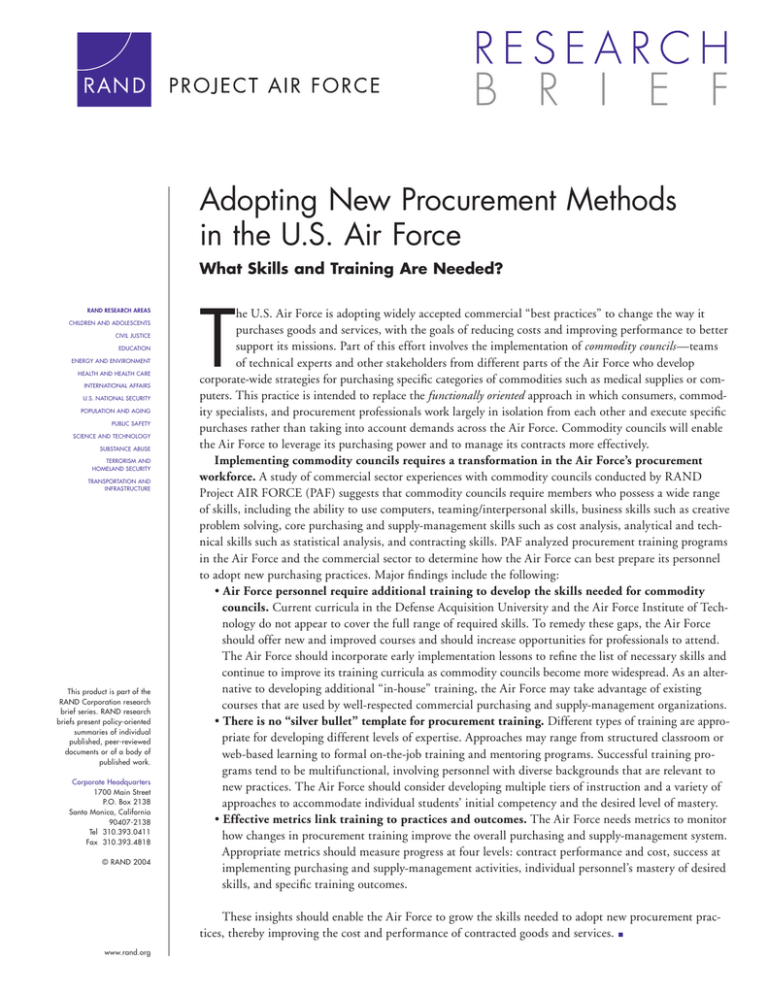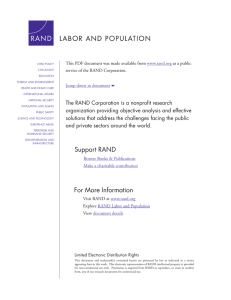T
advertisement

Adopting New Procurement Methods in the U.S. Air Force What Skills and Training Are Needed? RAND RESEARCH AREAS CHILDREN AND ADOLESCENTS CIVIL JUSTICE EDUCATION ENERGY AND ENVIRONMENT HEALTH AND HEALTH CARE INTERNATIONAL AFFAIRS U.S. NATIONAL SECURITY POPULATION AND AGING PUBLIC SAFETY SCIENCE AND TECHNOLOGY SUBSTANCE ABUSE TERRORISM AND HOMELAND SECURITY TRANSPORTATION AND INFRASTRUCTURE This product is part of the RAND Corporation research brief series. RAND research briefs present policy-oriented summaries of individual published, peer-reviewed documents or of a body of published work. Corporate Headquarters 1700 Main Street P.O. Box 2138 Santa Monica, California 90407-2138 Tel 310.393.0411 Fax 310.393.4818 © RAND 2004 T he U.S. Air Force is adopting widely accepted commercial “best practices” to change the way it purchases goods and services, with the goals of reducing costs and improving performance to better support its missions. Part of this effort involves the implementation of commodity councils—teams of technical experts and other stakeholders from different parts of the Air Force who develop corporate-wide strategies for purchasing specific categories of commodities such as medical supplies or computers. This practice is intended to replace the functionally oriented approach in which consumers, commodity specialists, and procurement professionals work largely in isolation from each other and execute specific purchases rather than taking into account demands across the Air Force. Commodity councils will enable the Air Force to leverage its purchasing power and to manage its contracts more effectively. Implementing commodity councils requires a transformation in the Air Force’s procurement workforce. A study of commercial sector experiences with commodity councils conducted by RAND Project AIR FORCE (PAF) suggests that commodity councils require members who possess a wide range of skills, including the ability to use computers, teaming/interpersonal skills, business skills such as creative problem solving, core purchasing and supply-management skills such as cost analysis, analytical and technical skills such as statistical analysis, and contracting skills. PAF analyzed procurement training programs in the Air Force and the commercial sector to determine how the Air Force can best prepare its personnel to adopt new purchasing practices. Major findings include the following: • Air Force personnel require additional training to develop the skills needed for commodity councils. Current curricula in the Defense Acquisition University and the Air Force Institute of Technology do not appear to cover the full range of required skills. To remedy these gaps, the Air Force should offer new and improved courses and should increase opportunities for professionals to attend. The Air Force should incorporate early implementation lessons to refine the list of necessary skills and continue to improve its training curricula as commodity councils become more widespread. As an alternative to developing additional “in-house” training, the Air Force may take advantage of existing courses that are used by well-respected commercial purchasing and supply-management organizations. • There is no “silver bullet” template for procurement training. Different types of training are appropriate for developing different levels of expertise. Approaches may range from structured classroom or web-based learning to formal on-the-job training and mentoring programs. Successful training programs tend to be multifunctional, involving personnel with diverse backgrounds that are relevant to new practices. The Air Force should consider developing multiple tiers of instruction and a variety of approaches to accommodate individual students’ initial competency and the desired level of mastery. • Effective metrics link training to practices and outcomes. The Air Force needs metrics to monitor how changes in procurement training improve the overall purchasing and supply-management system. Appropriate metrics should measure progress at four levels: contract performance and cost, success at implementing purchasing and supply-management activities, individual personnel’s mastery of desired skills, and specific training outcomes. These insights should enable the Air Force to grow the skills needed to adopt new procurement practices, thereby improving the cost and performance of contracted goods and services. www.rand.org This research brief describes work done for RAND Project AIR FORCE and documented in Air Force Procurement Workforce Transformation: Lessons from the Commercial Sector by John Ausink, Laura H. Baldwin, and Christopher Paul, MG-214-AF, 2004, 118 pages, ISBN: 0-8330-3648-3. Copies of this research brief and the complete report on which it is based are available from RAND Distribution Services (phone: 310-451-7002; toll free: 877-584-8642; or email: order@rand.org) or online at www.rand.org/publications/MG/MG214/. The RAND Corporation is a nonprofit research organization providing objective analysis and effective solutions that address the challenges facing the public and private sectors around the world. RAND’s publications do not necessarily reflect the opinions of its research clients and sponsors. R® is a registered trademark. RAND Offices Santa Monica RB-144-AF (2004) • Washington • Pittsburgh • New York • Doha • Berlin • Cambridge • Leiden CHILD POLICY CIVIL JUSTICE This PDF document was made available from www.rand.org as a public service of the RAND Corporation. EDUCATION ENERGY AND ENVIRONMENT HEALTH AND HEALTH CARE INTERNATIONAL AFFAIRS NATIONAL SECURITY POPULATION AND AGING This product is part of the RAND Corporation research brief series. RAND research briefs present policy-oriented summaries of individual published, peerreviewed documents or of a body of published work. PUBLIC SAFETY SCIENCE AND TECHNOLOGY SUBSTANCE ABUSE TERRORISM AND HOMELAND SECURITY TRANSPORTATION AND INFRASTRUCTURE The RAND Corporation is a nonprofit research organization providing objective analysis and effective solutions that address the challenges facing the public and private sectors around the world. Support RAND Browse Books & Publications Make a charitable contribution For More Information Visit RAND at www.rand.org Explore RAND Project AIR FORCE View document details Limited Electronic Distribution Rights This document and trademark(s) contained herein are protected by law as indicated in a notice appearing later in this work. This electronic representation of RAND intellectual property is provided for non-commercial use only. Permission is required from RAND to reproduce, or reuse in another form, any of our research documents for commercial use.




